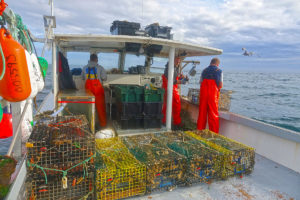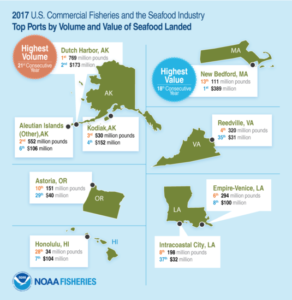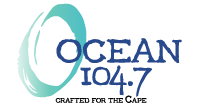 HYANNIS – Two reports released Thursday show continued progress in managing marine resources in the United States.
HYANNIS – Two reports released Thursday show continued progress in managing marine resources in the United States.
NOAA’s Fisheries Economics of the United States report shows that commercial and recreational fishing generated $212 billion in sales in 2016, contributed $100 billion to the Gross Domestic Product, and supported 1.7 million full- and part-time jobs – all up from 2015.
The industry was strengthened by growth in key species such as sea scallops and American lobsters, which is good news for the New England states.
“American lobster and sea scallops had the largest revenue increases from 2015 to 2016 with both products up $46 million in landings revenue,” said Ned Cyr, the director of NOAA Fisheries Office of Science and Technology.
In 2016, 87,000 jobs in Massachusetts were supported by the seafood industry. California was the only state in the country which supported more jobs, with 125,000.
The commercial fishing industry generated $144 billion in sales impacts and added $61 billion to the GDP. The domestic harvest produced $53 billion in sales, up 2 percent from 2015.
Economic impacts from recreational fishing grew across the board. Nationally, 9.8 million saltwater anglers took recreational fishing trips in 2016, which was a 9 percent increase from 2015.
Recreational fishing generated $68 billion in sales impacts.
 The Fisheries of the United States report for 2017 shows that landings and consumption of fish and shellfish increased from 2016.
The Fisheries of the United States report for 2017 shows that landings and consumption of fish and shellfish increased from 2016.
“Seafood consumption is up quite a bit with the average American eating 16 pounds of fish and shellfish in 2017,” Cyr said. “Up a significant 1.1 pounds from 2016.”
Commerical fishermen across the U.S. landed 9.9 billion pounds of fish and shellfish in 2017, up 3.6 percent from the previous year. That seafood was valued at $5.4 billion, which was up 2.1 percent from 2016.
“Both volume and value of fisheries landings increased from 2016,” Cyr said.
By volume, the nation’s largest commercial fishery remains Alaska Pollock, which had near record landings of 3.4 billion pounds valued at $413 million.
The report also highlighted the growing role for aquaculture in the domestic seafood industry.
U.S. marine and freshwater aquaculture production was valued at $1.5 billion in 2017.
“U.S. marine aquaculture production value was estimated at $418 million with oysters, clams and salmon generating the highest values,” Cyr said.
The fisheries report also shows that saltwater recreational fishing remains a key contributor to the national economy with 202 million marine fishing trips taken.
The top six recreational U.S. species ranked by harvested weight were striped bass, bluefish, red snapper, sheepshead, yellowfin tuna and red drum.
Cyr said U.S. ports are key to vibrant coastal communities and the seafood industry.
For the 21st straight year, Dutch Harbor, Alaska led the nation with the highest amount of seafood landed, 769 million pounds valued at $173 million.
New Bedford had the highest valued catch in the country for the 18th year in a row. The port landed 111 million pounds valued at $389 million.
“Eighty percent of that came from the highly lucrative sea scallop fishery,” Cyr said.
The U.S. imported 5.9 billion pounds of seafood in 2017, up 1.6 percent. Imports were valued at $21.5 billion, up around 10.4 percent.
“Shrimp, salmon and tuna continue to top the list of imports for 2017 which is similar to the previous year,” Cyr said.
While the U.S. continues to be a major importer of seafood, the Department of Commerce and NOAA are committed to addressing the United States seafood trade deficit through regulatory streamlining, increasing aquaculture production and creating a better, fairer trading system.
By BRIAN MERCHANT, CapeCod.com NewsCenter























